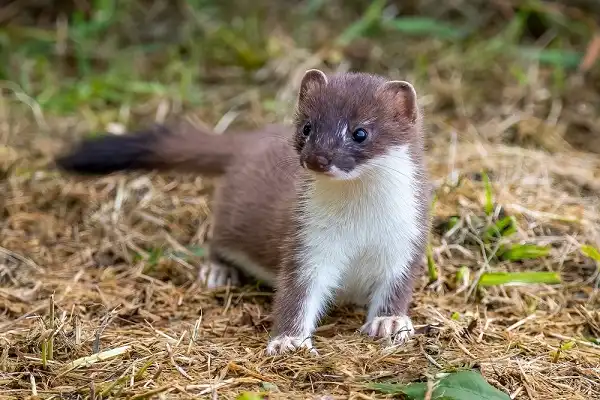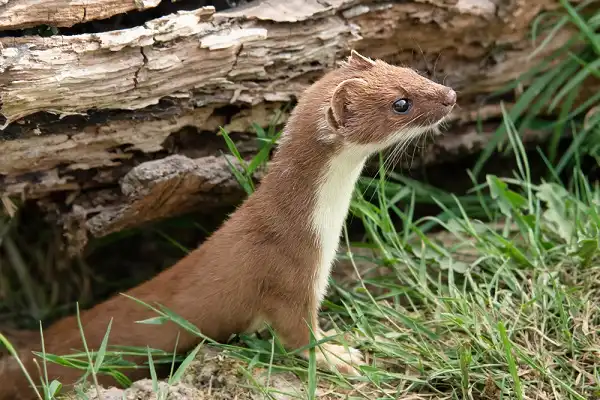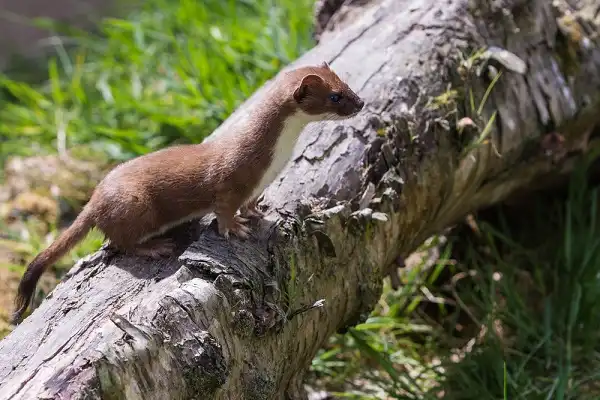As a wildlife enthusiast, you may have seen them on occasion – the sleek, brown-furred stoat bounding gracefully in and out of grasses or darting across open fields. But what do you really know about this mysterious creature? Explore with us these interesting facts about the stoat’s habitat, size, and diet while unraveling the mysteries behind their truly unique behavior. Whether it’s learning more about its hunting technique or how humans can help to preserve this species for future generations, you won’t want to miss this journey into discovering all that there is to know about this magnificent mammal.

Stoat Description
The stoat is a small mammal that is native to Europe, North Asia, and parts of North America. It is a member of the mustelid family, which includes other animals such as weasels, ferrets, and wolverines. The stoat has a long body with short legs. Its thick fur coat typically ranges between shades of black, white, brown, or even yellowish-gray. It has large ears and eyes that are set close together on the top of its head – a feature that helps it detect prey from long distances. Stoats have much longer tails than their relatives in the mustelid family; it can be almost twice as long as its body! This tail can act like an extra limb for balance when navigating through dense brush or jumping from tree to tree. The tail also acts as a rudder when swimming in water – giving them greater precision while diving underwater for food.
Stoat Habitat
The stoat is a highly adaptable species, living in a variety of habitats including woodlands, open fields, tundras, grasslands, and even coastal areas. They typically prefer areas with dense vegetation as it provides cover and shelter from potential predators. Stoats can also be found burrowing deep underground in order to construct their dens. Stoats are solitary creatures who use scent markings to identify and maintain territories. In order to find food, they will often wander great distances – traveling up to 6 miles each day! During the winter months, they may even hunt in pairs or small family groups in order to maximize their chances of catching prey. Stoats have also been known to live in human-made environments such as farms and parks – taking advantage of food sources like bird feeders or fishponds. Although these areas provide them easy access to food, they can sometimes come into conflict with humans due to their curious nature and love for mischief.
Stoat Diet
The stoat is an opportunistic feeder and will consume whatever prey it can find; this includes small mammals such as voles, mice, rabbits, and ground squirrels, but also birds, fish, reptiles, eggs, and sometimes even fruits and berries. They have powerful claws and sharp teeth that they use to tear apart their prey before consuming it. Stoats are mainly active during the night or early dawn when they hunt for food. They are highly agile predators who use their long tails to maintain balance while leaping from tree to tree in pursuit of their quarry. In addition, these nocturnal hunters use a technique called ‘stalking’ where they slowly creep up on unsuspecting prey until they can pounce or ambush them with surprise. This method of hunting is particularly effective against smaller animals like rodents or birds. Stoats also supplement their diet by scavenging through human garbage for leftovers or preying on domestic livestock such as chickens or lambs – although this behavior is not encouraged by farmers!

Stoat Size
The stoat is a small mammal with an average body length of 10 to 12 inches and a long and bushy tail that can be almost twice as long as its body. Its thick, short fur coat typically ranges from shades of black, white, brown, or even yellowish-gray. It has large ears and eyes that are set close together on the top of its head – a feature that helps it detect prey even from far away distances. In terms of mass, adult stoats usually weigh between 7–12 ounces (200–340 grams), with the females being slightly smaller than males. However, during the winter months, they may double in size due to increased fat reserves and thicker coats! The stoat’s front legs are shorter than their back legs allowing them to turn quickly and leap over obstacles when hunting for food.
Stoat Lifespan
The stoat has an average lifespan of 2 to 3 years in the wild, although they can live up to ten years in captivity. In the wild, they typically face many dangers such as predators, disease, and availability of food – all of which can limit their life expectancy. In terms of reproductive rate, stoats reach sexual maturity by one year old and will breed throughout the year, though most mating activities occur between April and August. After a gestation period of 28-32 days, female stoats will give birth to litters of usually 6-7 cubs each spring. The cubs are born blind and deaf but grow rapidly with the help of their mother’s milk; they become independent within 8-10 weeks. Stoats also have remarkable longevity for their size; even during harsh winters they often survive due to their thick fur coats which protect them from the cold. Additionally, they take advantage of denning behavior which allows them to conserve energy during periods when food is scarce; this can extend their lives significantly by reducing metabolic activity such as digestion or respiration.
Stoat Behavior
Stoats are highly intelligent creatures with complex social behaviors. They are territorial animals and use scent markings to identify their boundaries and defend them from intruders. They communicate with each other through a variety of vocalizations, including chirps, hisses, snarls, and growls. During courtship, males will perform elaborate dances for female mates in order to entice them and ensure successful mating. In addition to vocal communication, stoats also use body language to express themselves; for instance, they may arch their backs when threatened or flatten their ears when feeling threatened or excited. They also tap the ground rapidly with their hind feet in order to warn others of danger or signal submission.

Stoat Speed
The stoat has remarkable speed and agility, which makes it a highly efficient predator. It can run up to 30 mph (48 km/h) on land and swim up to 8 mph (13 km/h) in water. It’s short legs and long tail help them maintain balance while zigzagging across the ground or leaping from tree to tree with ease. The stoat can even jump up to 6 feet (2 meters) in the air! Not only is the stoat fast, but it is also incredibly stealthy; they are able to sneak up on unsuspecting prey by using a technique called ‘stalking’ where they slowly creep up without making any noise. This method of hunting makes them particularly effective predators against smaller animals like rodents or birds that rely on their eyesight for protection. In addition to their speed, stoats are also very agile climbers and can climb trees in search of food or potential mates. Their claws are sharp and well adapted for gripping onto branches, allowing them to use trees as techniques for escaping danger or surprise ambushing prey.
Stoat Hunting
The stoat is an incredible hunter, using a combination of speed, agility, and stealth to pursue its prey. It utilizes a technique called ‘stalking’ where it moves slowly and silently towards its target without alerting it, giving the stoat the upper hand in the hunt. The stoat will often use trees as vantage points to ambush unsuspecting prey such as rodents or birds. Stoats are also known for their uncanny ability to predict prey movements; they have been seen circling back around to find prey that they thought had escaped them. They can also detect scents from far away distances with their large ears and eyes set close together on the top of their head – a feature that helps them detect even small prey like mice or voles from great distances. In terms of equipment, the stoat has sharp claws on its front paws which help it capture and hold onto its victims; its hind feet are equipped with sharp claws which help in gripping onto surfaces like tree branches.
Stoat Reproduction
Stoat reproduction is an important part of the species’ survival in its natural habitats. Mating typically occurs between February and April, with females giving birth to litters of 4-7 kits in late spring or early summer. The kits are born blind and deaf but grow rapidly with the help of their mother’s milk; they become independent within 8-10 weeks. Males compete for access to female mates during the mating season, which can involve complex displays or courtship rituals such as dancing or vocalizations. Once they gain access, they will remain with the female for a few days before returning to their own territory. This behavior helps increase the chance that a female will give birth to healthy young with strong genetic diversity.

Conclusion
The stoat is a fascinating creature with complex behaviors and adaptations that have enabled it to survive in a variety of habitats across the globe for centuries. With their remarkable speed, agility, and hunting abilities this species has become an incredibly successful hunter. Additionally, they demonstrate remarkable levels of parental care, which helps ensure the survival of future generations. Through proper conservation measures, we can help protect these animals so that everyone can continue to admire their intelligence and spirit in our planet’s diverse wildlife for generations to come!
Frequently Asked Question


